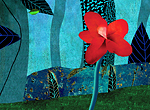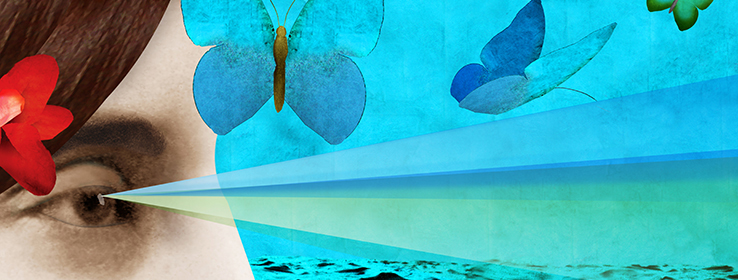Kim Palmer
These two hues share the same DNA - and often speak the same language.

By the time most children get to kindergarten, they can distinguish between blue and green in a box of crayons. But hundreds of years ago, even most adults couldn’t tell blue from green - not because they were color-blind, but because their languages didn’t have separate words for the colors. Instead, many cultures around the world relied on a single word that covered both colors. Some call it a “grue” term.
In ancient Chinese, the word qing could refer to blue, green or even black. Korean, Vietnamese and Thai also had one word for both blue and green, although it was sometimes modified to express variations. In Vietnamese, for example, the word xanh is used for both the color of leaves and the color of sky and sea, but the person might say xanh la cay (“leaf grue”) and xanh duong (“ocean grue”).
The blurring of blue and green wasn’t limited to the Far East. In traditional Turkish culture, blue and green were both called gok or “sky,” a term still used in many rural areas. Words that encompass both blue and green also exist in the languages of American Indian tribes, the Mayans and many Caribbean islands.
Why did so many cultures, on opposite sides of the globe, come up with such similar ways of lumping blue and green together? That’s a question that has long fascinated scientists and linguists.
The pattern of color
n 1969, two young scholars fresh out of grad school had a hunch that led to groundbreaking research about the language of color. “We had been taught that every language cuts up the spectrum differently, that it was arbitrary,” says Paul Kay, now a linguistics professor emeritus at the University of California-Berkeley and Stanford. But he and colleague Brett Berlin had each spent time in different cultures and discovered surprising language similarities with respect to color.
Berlin and Kay analyzed 98 languages and found that they tended to follow a common path toward defining colors. The first terms to emerge were those separating white from black (or light from dark), followed by red, then green, then yellow. But blue, as a separate hue from green, almost always emerged much later.
That was a radical notion, that there is a certain fixed order in which our brains organize color and color names arise. But it’s been reinforced by later research, including Berlin and Kay’s “World Color Survey” and a study by Terry Regier, in collaboration with Kay and Naveen Khetarpal, that used a computer model to map languages by organizing color chips.
Before blue
Blue was conspicuously absent from the works of Homer, the ancient Greek poet, according to science radio program Radiolab. In the mid-19th century, former British Prime Minister William Gladstone took it upon himself to catalog every color reference in both The Iliad and The Odyssey. There was not one mention of blue, although other colors were cited abundantly. Homer famously referred to the “wine-dark sea,” and described iron as “violet.”
Was Homer color-blind? Perhaps. But the original Hebrew texts of the Bible have no reference to blue either.
Some speculate that green and blue were late to separate because of practical reasons. There was no separate word for blue because there wasn’t a lot of blue around to talk about. The color is rare in plants, foods and animals. It was a difficult color to reproduce with the dyes of the time, while red was easily produced from dried red clay. With no blue dye and few blue things, there was no need for blue words.
The greening of Japan
Sometimes contact with another culture nudged the separation of blue and green. In Japan, the word ao was used for both colors for centuries. Then the word midori entered the lexicon, to describe the greenish end of the blue-green spectrum.
But midori didn’t fully come to mean green, a separate color, until the 20th century, according to the blog Empirical Zeal. “Japan got that from contact with the West,” says blogger Aatish Bhatia, a graduate student in biology at Rutgers University, whose June post about color naming went viral and won the Quark Science Prize.
In 1917, the first crayons were imported into Japan, bringing a way to divide the seamless rainbow into distinct chunks. There were different crayons for green (midori) and blue (ao), so children started using those terms. Then during the Allied occupation of Japan after World War II, educational materials separating the two colors started to circulate.
Yet even today, some blurring remains. Ao is still used to describe some vegetables and vegetation, as well as the color of traffic lights that signal “go,” even though most other green objects are called midori. While English speakers might urge children to “eat your greens,” the Japanese term for vegetables is ao-mono, or “blue things.”
The cataract theory
Why do cultures that blur blue and green tend to be closer to the tropics? Researchers Delwin Lindsey and Angela Brown theorized in 2002 that people closer to the equator are exposed to higher levels of ultraviolet radiation from sunlight, leading to yellowing of the ocular lens and making blue appear greenish.
But Kay, for one, disputes the notion that premature cataracts cause color distortion. “Old people with cataracts can see blue just fine,” he says. (He and Regier published a commentary, citing earlier research that shows people across cultures display remarkably similar dividing lines between colors, regardless of geography. They tend to divide blue and green right down the middle, not toward the greenish side.)
So why does Kay think blue and green are the last colors to separate? “Nobody knows,” he says. “It’s a mystery.” But we do know that the retina’s two-color coding axis splits blue and green in half, he notes. “This tells us that the signal from the retina is not what creates the categories. If all you know is what the retina is telling you,” Kay says, you would not see blue and green as the same color. “There has to be a lot more processing going on.”

Artists palette
Blues and greens, the hues of seas, skies and plants, have inspired countless artists through the ages. Picasso had his Blue Period, and Monet’s impressionist gardens and water lilies were awash in greens and blues. New York artist Jeanne Heifetz chooses mostly blues and greens for her woven-glass pieces exploring “color relationships.” When asked why, her answer is both poetic and practical: “When you work in glass, the cobalt blues are very beautiful; it’s hard not to be drawn to them,” she says. But when your medium is glass, blues and greens are also more plentiful and affordable. “The pigments of reds and oranges are very expensive.”
Qing: In ancient Chinese, the word qing could refer to blue, green or even black.
Xanh: In Vietnamese, the word xanh is used for both the color of leaves and the color of sky and sea, but the person might say xanh la cay (“leaf grue”) and xanh duong (“ocean grue”).
Gok: In traditional Turkish culture, blue and green were both called gok or “sky.”
Tȟó: Lakota differentiates blue and green only as shades of one color, Tȟó.
Yax: The Mayan word yax indicates both green and blue, and it’s also used to describe the softness of young plants and unripe fruit.
Heifetz has researched color naming extensively and authored a book, When Blue Meant Yellow, so she’s read the science about color and the brain. But she thinks the truth about why blue and green took so long to separate, especially in less developed cultures, is probably more practical and less complicated.
“The colors reflect the availability of dye stuff,” she says. “It does make sense to look at the natural world.”








